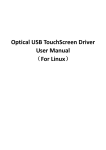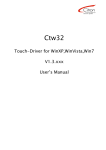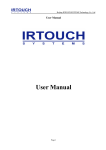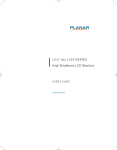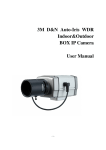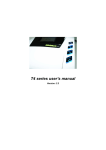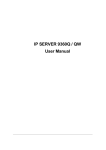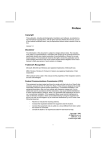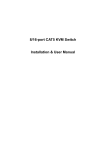Download Optical USB TouchScreen Driver User Manual
Transcript
Optical USB TouchScreen Driver User Manual (For Windows) ) Directory COPYRIGHT................................................................................................................................................................... 1 CONTACT INFORMATION ........................................................................................................... 錯誤! 尚未定義書籤。 1 2 3 INSTALLING DRIVER .............................................................................................................................................. 3 1.1 CONVENTIONAL INSTALLATION ..................................................................................................................................... 3 1.2 SILENT INSTALLATION ................................................................................................................................................. 7 TOUCHSCREEN CONTROL PANEL ........................................................................................................................... 8 2.1 MAPPING AND CALIBRATING ....................................................................................................................................... 8 2.2 SETTINGS............................................................................................................................................................... 13 2.2.1 Modes ............................................................................................................................................................ 14 2.2.2 Options........................................................................................................................................................... 15 2.2.3 Touch Sensitivity Settings ............................................................................................................................... 16 2.2.4 Right Click Settings......................................................................................................................................... 16 2.2.5 Beep Mode and Beep Type Settings ............................................................................................................... 17 2.2.6 Calibrate Settings ........................................................................................................................................... 17 2.2.7 Smoothness Settings ...................................................................................................................................... 18 UNINSTALLATION.................................................................................................................................................19 ATTACHMENT - GENERAL SETTING OF THE TOUCHSCREEN (AS REFERENCE) ................................................................21 Copyright PLEASE READ THIS AGREEMENT CAREFULLY BEFORE USING THE DRIVER. THE PROGRAM WILL BE LICENSED TO YOU ONLY IF YOU FIRST ACCEPT THE TERMS OF THIS AGREEMENT. BY USING THE PROGRAM YOU AGREE TO THESE TERMS. IF YOU DO NOT AGREE TO THE TERMS OF THIS AGREEMENT, PROMPTLY RETURN THE UNUSED PROGRAM TO THE PARTY FROM WHOM YOU ACQUIRED IT TO RECEIVE A REFUND OF THE AMOUNT YOU PAID. The term "Program" means the original program and all whole or partial copies of it. A Program consists of machine-readable instructions, its components, data, audio-visual content (such as images, text, recordings, or pictures), and related licensed materials. 1. LICENSE IRTOUCH grants you a nonexclusive license to use the Program. You may 1) use the Program to the extent of authorizations you have acquired and 2) make and install copies to support the level of use authorized, providing you reproduce the copyright notice and any other legends of ownership on each copy, or partial copy, of the Program. If you acquire this Program as a program upgrade, your authorization to use the Program from which you upgraded is terminated. You will ensure that anyone who uses the Program does so only in compliance with the terms of this Agreement. You may not 1) use, copy, modify, or distribute the Program except as provided in this Agreement; 2) reverse assemble, reverse compile, or otherwise translate the Program except as specifically permitted by law without the possibility of contractual waiver; or 3) sublicense, rent, or lease the Program. TRANSFER OF RIGHTS AND OBLIGATIONS You may transfer all your license rights and obligations under the written permission by IRTOUCH for the Program to another party. The transfer of your license rights and obligations terminates your authorization to use the Program. 2. GENERAL Nothing in this Agreement affects any statutory rights of consumers that cannot be waived or limited by contract. IRTOUCH may terminate your license if you fail to comply with the terms of this Agreement. If IRTOUCH does so, you must immediately destroy the Program and all copies you made of it. ANY ACTION OF INFRINGING THE COPYRIGHT AGREEMENT WILL BE SUED FOR. 1 3. TRADEMARK ACKNOWLEDGEMENTS IRTOUCH is registered trademark by IRTOUCHSYSTEMS Technology Co., Ltd, Any company or individual will not have right to use, copy, modify, excerpt, sale the all parts of the brand or without any written-permission by IRTOUCHSYSTEMS. 2 1 Installing Driver 1.1 Conventional Installation Step1:Double-click driver installation “setup.exe” , interface into the driver installation; Notes: If your computer system is Windows Vista, please right click “setup.exe” and choose “Run as Administrator”. Step2:The default installation path of the driver is “C:\Program Files\TouchScreen”, you can click “Change…” to select another installation path, and then click “Next”, as shown in: 3 Step3:Driver installation is complete, click “Finish” to close the wizard, as shown in: Step4:Plug the end of the USB connecting line to the USB port of the computer, then toolbar at the lower right corner of the computer prompts:”Found New Hardware”, as shown in the following figure. The new hardware is installed and ready to use: Notes: Now the driver has been installed to your computer, system will automatically retrieve the driver. But it is suggested that you restart your computer and please wait 5 seconds before you use the touchscreen. And moreover, some computers need to take the following steps to find the new driver. 4 Step5:In the pop-up “Found New Hardware Wizard” window, choose “No, not this time”, and then click “Next” to continue, as shown in: Step6:Choose “Install the software automatically”, and then click “Next”, as shown in: 5 Step7:Click “Finish” to complete the driver installation, as shown in the following figure. Toolbar at the lower right corner of the computer prompts:”Found New Hardware”, the new hardware is installed and ready to use: Notes: If hardware compatibility warning appears during the installation, please click “Continue Anywhere”, as shown in: 6 Notes: In order to use the driver better, for Windows Vista and above computer operating editions, it is suggested that you close UAC (User Account Control). Method is as follows: open “Control Panel”-“User Accounts”-“User Account Control Settings”, choose “Never notify” from “Choose when to be notified about changes to your computer”, as shown in: 1.2 Silent Installation Step1:Follow “Start”-“Run” and input “cmd” to enter DOS operating environment; Step2:Input the driver installation package folder’s path, and then click “Enter”; Step3:Run the command line: “setup /S”, and then click “Enter” to start the installation driver. 7 2 TouchScreen Control Panel Double-click the shortcut button on the desktop, open the TouchScreen Control Panel, as shown in: 2.1 Mapping and Calibrating 1. Mapping: TouchScreen Control Panel provides adjustment and configuration with touchscreens, and supports compatibility of multi-touchscreens at the same PC. The panel shows the basic information of the touchscreen and calibration. If several touchscreens are mounted on the PC and the system is set to 8 “multi-screens display”, then all the touchscreens will be shown in the Touch Screen List. Before calibrate each touchscreen, you need to set the corresponding relationships between the monitors and the touchscreens, otherwise the touchscreens won’t work. The method is: click [Mapping] button on TouchScreen Control Panel, the setting window pops up, as shown in: Select a touchscreen from [TouchScreen List], choose a number for the touchscreen from the drop-down menu of [TouchScreen No.]. And then choose a monitor related to the touchscreen from the drop-down menu of [Monitor No.]. You can click the [Identify] button, and then on the selected monitor will display its number, so you can know which monitor is selected. After you have set the corresponding relationships between the monitors and the touchscreens, click [OK] button to save and exit. Notes: For Windows 7 computer systems, the function of “Mapping” is gray and not optional. If you need, please use the similar functions of the operating systems’. 2. Calibrate: After setting the corresponding relationships between the monitor and the touchscreen, you can calibrate each touchscreen. The method is to choose a touchscreen from the list, click [Calibrate] and the calibration window appears. Calibration is done by clicking the center of each butt mark one after the other, as shown in: 9 There are optional two ways of calibration: 4 points and 25 points. See “2.2.6 Calibrate Settings” for reference. The mode of “Click on Release” (see “2.2.1 Modes” for reference) is used when calibrating. So you can move the pointer or finger without lift until hitting the center of the butt mark. When calibrating, you can right-click to return to the previous calibration point and restart to calibrate from that point. When calibrating, you can press “Esc” key to exit. After calibration, three buttons appear, as shown in: 10 ① [ReCalibrate]:to calibrate again; ② [OK]:to save the calibration result and exit; ③ [Cancel]:to exit without saving the calibration result. After calibration, red circle in the center of the touchscreen becomes blue tick, as shown in: 3. Region Calibrate: Using the function of “Region Calibrate”, you can set the touch region and calibrate it. Steps as follows: (1) Choose a touchscreen from the list, click [Region Calibrate] button; (2) The regional calibration window appears, as shown in: 11 Move the cursor to the edge of the region, the cursor will become , and then you can drag to adjust the width and height of the touch region. Right-click on the touch region, then you can use the pull-down menu to choose a presupposed region: ① Full Screen: the touch region will be set to the full screen area; ② Left-Right: choose Left/Right and the touch region will be set to the left/right half of the screen area; ③ Up-Down: choose Top/Bottom and the touch region will be set to the upper/lower half of the screen area; ④ Quarter: choose Left-Top/Right-Top/Left-Bottom/Right-Bottom and the touch region will be set to the upper left/ upper right/lower left/lower right quarter of the screen area. 12 Notes: Whether you drag to adjust the touch region, or choose a presupposed region from the pull-down menu, you can only by mouse operation, but not by touch operation. (3) After you have setting the region that you want to touch, click the center of each butt mark one after the other to calibrate. There are also optional two ways of regional calibration: 4 points and 25 points. See “2.2.6 Calibrate Settings” for reference. The mode of “Click on Release” (see “2.2.1 Modes” for reference) is used when regional calibrating. When regional calibrating, you can right-click to return to the previous calibration point and restart to calibrate from that point. When regional calibrating, you can press “Esc” key to exit. (4) After clicking all the points, three buttons appear, the same as “Calibrate”. After regional calibration is complete, you can touch on the selected touch region. At this point, red circle in the center of the touchscreen becomes blue tick. 4. Reset: Choose a touchscreen from the list, click [Reset] to abandon the previous calibration result and use the default calibration data. Blue tick in the center of the touchscreen becomes red circle. 2.2 Settings Click the [Settings] button on the TouchScreen Control Panel, the “Settings” panel appears, as shown in: 13 Notes: For the detailed descriptions of those functions, you can refer to the introduction of the rest of this chapter. You can flexibly set related parameters according to hardware statuses and external factors, so as to achieve the best practical effects. See “Attachment - General setting of the touchscreen (As reference)” for reference. 2.2.1 Modes There are three touch modes: 1. Click on Touch: Mouse single click event happens immediately at the point when the finger contacts the touchscreen. The mode is applied only to click objects, but not to drag objects. Touchscreens in the mode responds fastest and are usually used for clicking big buttons. Under this mode, Beep mode 14 that can be used is only “Beep on Touch”. 2. Click on Release: Mouse single click event happens at the point when the finger leaves the touchscreen. You can move the pointer or finger without lift until you accurately hitting the object that you want to click. Touchscreens in the mode are usually used for clicking small buttons or clicking hyperlinks on a Web page, such as POS and Web applications. Under this mode, Beep mode that can be used is only “Beep on Release”. 3. Mouse Emulation: Default mode of the driver. Full emulation of mouse functions, including left-clicking, moving, lifting, and dragging objects. The mode is very suitable to the following applications: writing, drawing, and dragging maps. Under this mode, you can choose any mode among the three Beep modes. Tips: For Windows 7 computer systems, the option is “Touch Mode”. 2.2.2 Options 1. Enable Touch: Enable (default)/disable touchscreen. 2. Hide Cursor: Hide cursor without turn off the mouse functions. Because mouse cursor is not necessary in some cases, such as clicking big buttons, playing animations and children education in “Click on Touch” mode. 3. Enable Right Click: Enable (default)/disable right click function. Click and press on any area of the screen for a while, then the right-click pop-up menu will appear. This function is only available in “Touch Mode” mode. 15 You can set the features of the function in “Right Click Settings” on the right side of the panel. See “2.2.4 Right Click Settings” for reference. 4. Enable Beep: After checking the option, Beep mode enables. As a result, when mouse click event happens, a sound tip prompts. You can set the features of the function in “Beep Mode” and “Beep Type Settings” on the right side of the panel. See “2.2.5 Beep Mode and Beep Type Settings” for reference. Notes: For Windows 7 computer systems, the functions of “Hide Cursor” and “Enable Right Click” are gray and not optional. If you need, please use the similar functions of the operating systems’. 2.2.3 Touch Sensitivity Settings Through touch sensitivity settings, you can set a number of touch delay (Delay) to allow a time for the fingers’ lifting and dropping when touching. You can also set an allowed touch scope (Area) as the fingers’ stay area. You can set the features of the function in “Touch Sensitivity Settings” on the right side of the panel: ① Delay:to adjust the number of touch delay, the higher the value, the longer the delay time, range from 50~1000 (unit: millisecond). ② Area:to adjust the effective area of the touch scope, the higher the value, the wider the effective area, range from 0~50 (unit: millimeter). 2.2.4 Right Click Settings You can set the features of the function in “Right Click Settings” on the right side of the panel: ① Delay:to set the pop-up time, the higher the value, the slower the pop-up time, range from 1000~8000 (unit: millisecond). 16 ② Area:to adjust the jitter-range of the touch surface within limit of error, the higher the value, the wider the jitter-range, range from 4~32 (unit: millimeters). After setting, right-click menu will pop up so long as the finger contacts the screen for a while (Delay) within the range (Area). 2.2.5 Beep Mode and Beep Type Settings You can choose a beep mode from “Beep Mode” on the right side of the panel: ① Beep On Touch:sound tip prompts immediately when the finger contacts the touchscreen. ② Beep On Release:sound tip prompts at the point when the finger leaves the touchscreen. ③ Both:sound tip prompts when the finger contacts and leaves the touchscreen. Under this mode, only “Touch Mode” can be used. You can set the features of the mode in “Beep Type Settings”: ① PC Speaker:send out beep through the default PC card, and you can adjust the frequency (Frequency)and duration (Duration) of beep to change the sound. ② Sound Card:send out sound through the sound card. Notes: “PC Speaker” and “Sound Card” are mutually exclusive, you can only choose one of them. And for Windows XP and Windows Vista of 64 bits, “PC Speaker” is not supported. 2.2.6 Calibrate Settings There are optional two ways of calibration: ① 4 Points:4 points calibration. ② 25 Points:25 points calibration. By default, 4 points calibration is used. 17 2.2.7 Smoothness Settings You can drag the slider to adjust the value of the smoothness, from 0 to 5. Tips: The higher value of the smoothness, the better effect of writing or drawing, but the higher requirement of the computer system configuration. The lower value of the smoothness, the faster of writing or drawing. It is recommended that you use the default setting (the value set to 1). 18 3 Uninstallation Step1:Click “Control Panel”-“Add or Remove Programs”, select “Optical USB TouchScreen” from the list, then click “Remove” button to uninstall the driver, as shown in: Step2:Click” Next” to start the uninstallation driver, as shown in: 19 Step3:Driver uninstallation is complete, click “Finish” to close the wizard, as shown in: 20 Attachment - General setting of the touchscreen (As reference) Select “Mouse Emulation” mode, then check “Enable Touch” and “Enable Right Click” in “Options”. Whether checking “Hide Cursor” or “Enable Beep” depends on your actual conditions. Setting Description: 1. Touch Sensitivity Settings: : Through touch sensitivity settings, you can set a certain time and scope for the fingers’ lifting and dropping when touching. In general, “Delay” is set to 500ms (0.5 second), “Area” is set to 8mm. 2. Right Click Settings: : Click and press on any area of the screen for a while, then the right-click pop-up menu will appear. This function is only available in “Touch Mode” mode. In general, “Delay” is set to 1000ms (1 21 second), “Area” is set to 8mm. 3. Smoothness Settings You can drag the slider to adjust the value of the smoothness, from 0 to 5.The higher value of the smoothness, the better effect of writing or drawing, but the higher requirement of the computer system configuration. The lower value of the smoothness, the faster of writing or drawing. It is recommended that you use the default setting (the value set to 1). (Please refer to the User Manual for detailed information.) 22
























